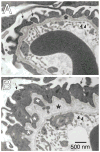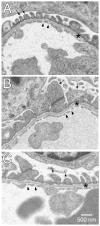Alport syndrome and Pierson syndrome: Diseases of the glomerular basement membrane
- PMID: 29673759
- PMCID: PMC6146048
- DOI: 10.1016/j.matbio.2018.04.008
Alport syndrome and Pierson syndrome: Diseases of the glomerular basement membrane
Abstract
The glomerular basement membrane (GBM) is an important component of the kidney's glomerular filtration barrier. Like all basement membranes, the GBM contains type IV collagen, laminin, nidogen, and heparan sulfate proteoglycan. It is flanked by the podocytes and glomerular endothelial cells that both synthesize it and adhere to it. Mutations that affect the GBM's collagen α3α4α5(IV) components cause Alport syndrome (kidney disease with variable ear and eye defects) and its variants, including thin basement membrane nephropathy. Mutations in LAMB2 that impact the synthesis or function of laminin α5β2γ1 (LM-521) cause Pierson syndrome (congenital nephrotic syndrome with eye and neurological defects) and its less severe variants, including isolated congenital nephrotic syndrome. The very different types of kidney diseases that result from mutations in collagen IV vs. laminin are likely due to very different pathogenic mechanisms. A better understanding of these mechanisms should lead to targeted therapeutic approaches that can help people with these rare but important diseases.
Copyright © 2018 Elsevier B.V. All rights reserved.
Figures




References
-
- Miner JH. Building the glomerulus: a matricentric view. J Am Soc Nephrol. 2005;16(4):857–861. - PubMed
-
- Harvey SJ, Jarad G, Cunningham J, Rops AL, van der Vlag J, Berden JH, Moeller MJ, Holzman LB, Burgess RW, Miner JH. Disruption of glomerular basement membrane charge through podocyte-specific mutation of agrin does not alter glomerular permselectivity. Am J Pathol. 2007;171(1):139–152. - PMC - PubMed
Publication types
MeSH terms
Substances
Supplementary concepts
Grants and funding
LinkOut - more resources
Full Text Sources
Other Literature Sources

